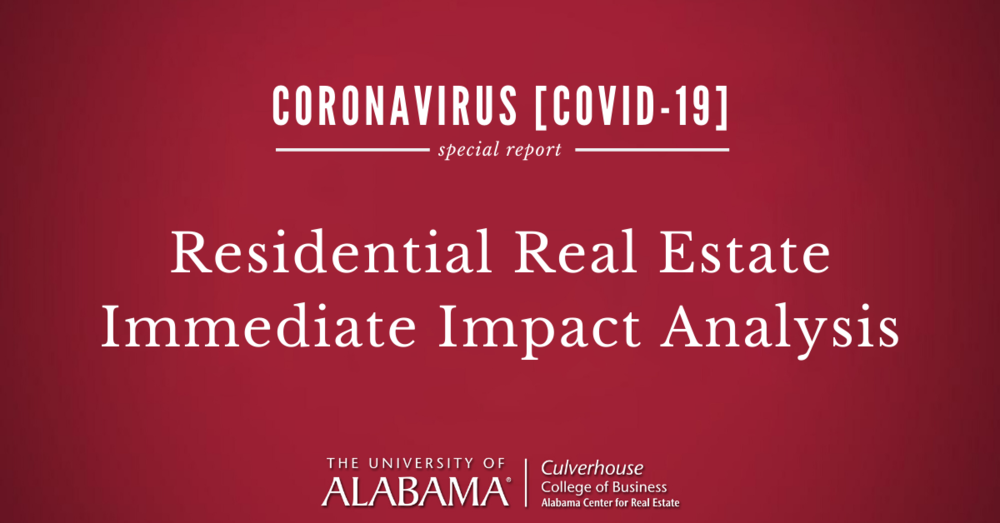Home is where we are isolating ourselves from Covid-19 – and the latest data suggests it is not only a safe place to isolate, but thus far its value is more stable than Wall Street as well. As ACRE continues to track and report on the performance of the housing market, during this Coronavirus outbreak we will also be analyzing the relevant new data releases for any signs of a housing virus or crisis like we evidenced 2007-2010. The news thus far is home is the place to be.
ACRE has been communicating with home builders since the onset of this outbreak in February at both the state and national levels to assess how early spring traffic and sales are emerging from the normal winter pause. Builder and new housing data sources, such as MetroStudy (a leading provider of primary and secondary market information to the housing and residential construction industry which surveys new home construction communities in over 100 MSAs) are reporting “weekend sales traffic and contracts in the first two weeks of March are in line with the past two March periods” – or robust. However, there are three early warning signs being reported anecdotally that are also surfacing in new data releases this week from both the National Association of Homebuilders (NAHB) in their monthly builder survey (HMI) covering the period February 6 thru March 6, as well as the U.S. Census Bureau in its monthly update of housing Starts and Permits. The three items to note include:
1. Transitioning from walkthough/open house showings to virtual tours and completing due diligence (like home inspections and appraisals) is presenting challenges.
2. Supply-chain disruption of materials and components (like faux bathroom fixtures made in China) are adversely impacting between 25 – 35% of new home construction. The anticipated impact is deliveries of new homes may be delayed this spring and summer.
3. Closings and mortgage document recording at courthouses where access is being restricted is expected to delay home transaction closings.
4. New supply is moderating but not to levels that should cause concern – yet.
Transitioning from walkthough/open house showings and completion of due diligence: Real estate professionals are having to pivot from traditional walkthough/open house showings to virtual tours as neither homeowners or prospective buyers are excited about touring homes where people are quarantining themselves. The transition will occur quickly, but some technology and regulatory relief may be needed. The good news here is that this trend was underway and will likely get an extra push from the coronavirus outbreak just as grocers are experiencing from a surge in online grocery ordering.
The more concerning aspect is the disruption to the normal due diligence in the home transaction process. Home inspectors, appraisers, and photographers are exercising caution and only visiting homes when they can be empty. This is a logistical/scheduling problem to anticipate upfront. The good news is that neither home inspection or appraisal industry organizations are reporting shortages of professionals due to the virus. Some jurisdictions like San Francisco and New York have added a wrinkle to completion of due diligence with “Shelter-in-Place” orders. This too is viewed as a short-term issue and not something systemic that will materially impact new or existing home transactions – yet.
Supply Chain Disruption: This week, the NAHB shared in its March report (February 6 – March 6, 2020) that home builders are still optimistic about housing. The NAHB reported the housing market index (HMI) was at 72, down slightly from 74 in February. Any number above 50 indicates that more builders view sales conditions as good. From a historical perspective, the 72 score is still considered high and near record readings dating back to 1999. As you can see in the two NAHB tables below, the October 2019 to March 2020 period was the second longest period of above 70 readings since the 1998-1999 period. And on a regional basis, this HMI score translates second highest to only the West.

That is the good news. The early warning sign, though, in this latest NAHB HMI report is two-fold:
First, the builders who responded to the survey before February 28th were much more optimistic than those that responded after that date, up until the respondent deadline of March 6th.
Second, all respondents reported that supply chain disruption is their top concern, rather than weak traffic or sales. Between 25 – 35% of all builders are reporting problems due to materials or components inbound from China – such as bathroom fixtures. It’s not just a shortage of toilet paper due to the virus, it’s the entire bathroom fixture. Many homeowners would be surprised to learn that the U.S. sends “fluff-pulp” to China (and a lot of it through Port of Mobile) for the manufacture of paper products like diapers and toilet paper. And a large percentage of bathroom fixtures are also made in China for new homes, apartments, and hotel rooms.
Closings & Mortgage Document Recording: Real estate professionals and consumers need to anticipate a slower or extended closing period through this summer season. Why? Just as we are isolating ourselves and reluctant to interact with the population at large, so too are critical vendors and closing specialists. Home inspectors, appraisers, title surveyors, as well as closing attorneys and the clerk of the court at courthouses are restricting access and spreading out due diligence and closings. It is all manageable if you budget a longer closing period and think about when to rate lock or establish drop-dead dates in contracts. As long as you anticipate a longer process and think about the hard dates, all should work fine.
New supply is moderating, but not yet to levels that should cause concern. This week the Census Bureau gave us updated data on new home starts and permits. While the total figures dipped slightly, they are still quite healthy and don’t nearly address the pent-up demand for new homes. Before the virus outbreak, U.S. communities lacked sufficient inventories to meet demand – thus any slowing in construction or permit issuance would exacerbate the inventory shortage the market was already experiencing. Under this scenario, home prices could continue moderate upward momentum. Below are the two key charts from the U.S. Census regarding starts and permits – note completions are steady and inventory is being delivered into most markets now and the next 60-90 days.

Comments directly from the Census Bureau regarding permits, starts and completions are good and any slight dips and increases between the January/February/March periods are typical due to weather and other variables. Focus on the year-over-year change. Finally, I will caution that the one “What-If” metric to monitor that could change the whole housing picture is employment and job layoffs. If we see material layoffs follow in the second-half or March and April and unemployment spike to 5% or higher levels from the current lows of 3.5%, homebuyer confidence will be impacted and sales activity will likely slow. Along with housing data, also keep an eye on three metrics going forward: i) weekly jobless claims – they rose in February but are still below the threshold 300,000 mark; ii) help-wanted ads – they fall as a precursor to a rise in jobless claims and layoffs. Go to your State Department of Labor website to track (in AL it is ALDOL – AL Dept of Labor Stats); and iii) the monthly employment situation reports by both ADP and BLS the first Wednesday and Friday of each month. Alabama headed into the coronavirus outbreak with record employed persons and record low unemployment. We will need to keep an eye on developments from K-12 school/university closings and auto plant closures starting this week.
Comments from the U.S. Census Bureau on March 18, 2020:
Building Permits: Nationally, “privately‐owned housing units authorized by building permits in February were at a seasonally adjusted annual rate of 1,464,000. This is 5.5% (±1.5%) below the revised January rate of 1,550,000, but is 13.8% (±2.1%) above the February 2019 rate of 1,287,000. Single‐family authorizations in February were at a rate of 1,004,000; this is 1.7% (±1.4%) above the revised January figure of 987,000. Authorizations of units in buildings with five units or more were at a rate of 415,000 in February.”
Housing Starts: Nationally, “privately‐owned housing starts in February were at a seasonally adjusted annual rate of 1,599,000. This is 1.5% (±12.4%) below the revised January estimate of 1,624,000, but is 39.2% (±17.7%) above the February 2019 rate of 1,149,000. Single‐family housing starts in February were at a rate of 1,072,000; this is 6.7% (±13.9%) above the revised January figure of 1,005,000. The February rate for units in buildings with five units or more was 508,000.”
Housing Completions: Nationally, “privately‐owned housing completions in February were at a seasonally adjusted annual rate of 1,316,000. This is 0.2% (±12.4%) below the revised January estimate of 1,319,000 and is 1.2% (±14.8%) below the February 2019 rate of 1,332,000. Single‐family housing completions in February were at a rate of 1,027,000; this is 14.1% (±14.1%) above the revised January rate of 900,000. The February rate for units in buildings with five units or more was 280,000.”
ACRE will continue to post updates and commentary on the impact of COVID-19 on the WIN, on our media platform exploRE and on our LinkedIn page.
If you have any specific questions or if you have a media inquiry, please email acremedia@culverhouse.ua.edu.





